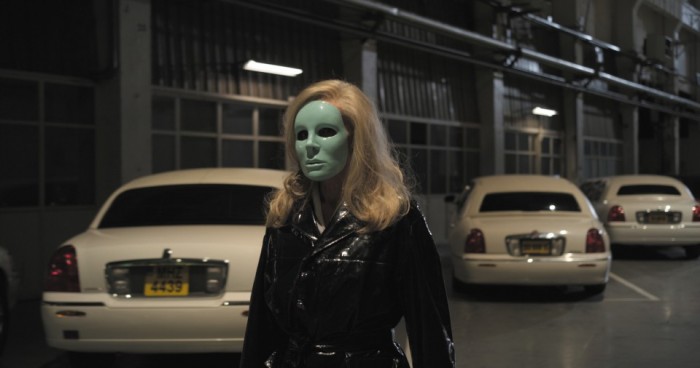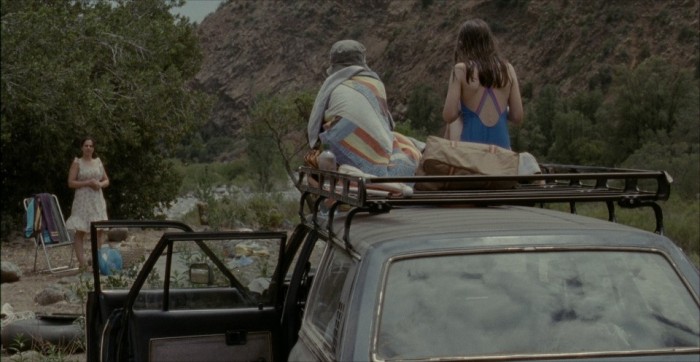Welles, Bergman, Truffaut, Kurosawa, Wenders, Godard, Polański, Hawks, Oshima, Shindo, Fellini, Antonioni, Fassbinder, Tati, Keaton, Chaplin and many, many more: all of them are featured on the walls of the apartment belonging to Shuji, an independent Japanese filmmaker and activist. His place is literally teeming with cinematography, the shelves are stacked with films on reels, books on film, VHS tapes and DVDs, the windows are taped over with posters and photographs, while the terrace holds a projections screen and chairs for the audience.
Shuji often screens masterpieces of cinema at his apartment and spends his days running around the city, disseminating his manifestos through a handy bullhorn. There’s no hope in them, they’re filled with regret and repulsion. The young idealist can’t find a place for himself in the world, he curses the multiplexes, the Dream Factory, he rebels against the commercialisation, he doesn’t like marketing people, and keeps emphasising that the cinema can’t be a prostitute, that it has to be free. He’s trying to convince whomever he can that we need to return to the ways of the past, to a time when everything felt “well-grounded, both in itself and in time”. It’s hard to say where people like that come from; there’s something terribly annoying about them — they’re always complaining and prone to self-flagellation.
One day a group of Yakuza hoods meet the young cinema enthusiast and bring him sad news: Shuji’s brother is dead, and he has to pay off the late brother’s debt or he’s going to be in deep trouble himself. The manifesto author goes to see the place his brother died at, and it turns out that a boxing arena is the crime scene. The gangsters use it as a gambling den and work out their frustration with losing on a punching bag. The innocent debtor arrives at an idea: he offers himself as a new punching bag in exchange for an appropriate amount of money for each hit.
While weathering the blows, Shuji tries to think about anything but pain, so he thinks about cinema. He loudly repeats fragments of his manifestos, reminisces on the screenings he hosted, to withstand a hundred punches he quotes cinema’s most influential films. The tiny audience gathered at the screenings of Amir Naderi’s Cut applauded loudly when the film’s protagonist mentioned two Polish flicks: Knife in the Water and The Decalogue.
Naderi’s film is no masterpiece; you need to have Zen-like abilities to sit through at least 70 minutes of violence graphically inflicted on Shuji mixed with witnessing his visits at the graves of Japan’s greatest filmmakers: Kurosawa, Mizoguchi and Ozu. But I couldn’t think of a better flick to end the festival with. Most of us sang along with R.E.M.’s “It's the End of the World as We Know It (And I Feel Fine)” and most of us omitted the words in the parentheses. Bad things have unpleasant beginnings, the mourning has just begun: mourning for a cinema that’s long gone, and for an audience that’s no longer there.
A similar sentiment was present in Holy Motors, the new film of French director Leos Carax, widely known for his claim that he watches no more than two or three films per year. His film opens with a shot of a cinema audience which — unlike in the opening of Hanneke’s Love — is fast asleep. Nobody’s really interested in cinematography anymore — the sentiment returns in another form, in another scene, in which a bunch of mannequins lies discarded in a run-down, dusty cinema that closed down a long time ago, turned off film cameras still clutched tightly in their artificial hands.
 Holy Motors, dir. Leos Carax, photo: T-Moblie New Horizons
Holy Motors, dir. Leos Carax, photo: T-Moblie New Horizons
The screening is impossible so it has to be simulated in the real world. When describing Eric Parker, the protagonist of his novel Cosmopolis, Don DeLillo writes: “Nothing existed around him. There was only the noise in his head, the mind in time.” One day, Parker decides to visit a hairstylist in a white limo. Oscar, a character in Holy Motors, travels in a similar vehicle, also moving as if nothing exists around him. Oscar’s endeavor is also marked by a sequence of encounters, but there is one difference — his encounters are not spontaneous but staged.
The man in the limo takes on different roles, carefully picking out props, costumes, and prepping the right make up before each performance. He becomes a beggar, a Jedi knight working at a film set, a flower-eating monster, a dying magnate, a late lover, a rogue, a father trying to imbue his daughter with self-confidence. He’s working for a syndicate, one of many who roam the streets of Paris trying to create films. He’s slowly losing his strength, he starts doubting whether his performances, lacking an audience and intended as a tribute to filmmakers and film itself, mean anything in a world taken over by cameras. If “beauty lies in the eye of the beholder” and there’s no beholder to speak of, that means that beauty is gone — that’s the message of Carax’s Holy Motors, possibly the most energetic film at this year’s New Horizons Festival, and the auditorium was packed for each screening.
That “the end is nigh” feeling also emanated from Philippe Grandrieux’s The Beauty May Have Strengthened Our Resoluteness – Masao Adachi. Adachi, a filmmaker from Japan, stopped making films in the 1970s and tried his hand at revolution, joining up with the militants from the Japanese Red Army. Now he tells his younger colleague that he always wanted to make films but the order between the eyes was simply more important for him. Although his revolutionary attempts failed, although they ended with his arrest, although Grandrieux’s film is steeped in darkness punctuated by the appearance of the calm face of the old revolutionary still fascinated with surrealism and Buddhism, Adachi still looks to the future with calm and curiosity. Even though true cinematography is supposedly a dead art in this day and age, Adachi wants to go back to directing, maybe even acting.
The fear of popcorn and the mainstream, the unwillingness to combine high and low cultures was fairly evident in lots of places. Roman Gutek, who completed his takeover of the Helios multiplex in Wrocław just before the start of the festival, announced that he’s turning it into an arthouse cinema that won’t be screening American blockbusters anymore. When speaking with jounalists, Carlos Reygadas said that he cannot imagine that someone could enjoy his films and Batman. Meanwhile, a big chunk of festival attendees went to an ordinary multiplex to see the premiere screening of the newest Batman installment just after midnight; later that same group sincerely enjoyed the Mexican director’s films.
We can spend time charmingly elaborating on the end of things, but the festival seems to defy all the pessimistic prognostications. It seems that all is well – and right where it’s supposed to be. The audience flocks to the cinemas, they want to watch films, and they have lots to choose from. The festival programme has a few hundred films, including the classics, Mexican and American cinema, films about art, documentaries, some of them really extreme, but their directors were able to make them, they achieved their goals, so what’s there to cry about? Should we scream, like the protagonist of Cut, that cinema has prostituted itself out when it has simply expanded into new fields and forms? I saw a lot of great films in Wrocław this year, there really is no reason to complain.
Despite apocalypse and reaching bottom being the predominant themes at this year’s festival, you could easily escape the doom and gloom, you just had to choose well, for example Paolo Sorentino’s The Family Friend – a history of a beautiful catastrophe which uses “My Lady Story” by Antony and the Johnsons as a recurring refrain. The maudlin song serves as a theme for Geremia – an eyesore loan shark who lives with his mother and is unable to feel love towards anybody until he meets the beautiful Rosalba, a young woman of principle who doesn’t shy away from making sacrifices.
Geremia is like Shylock, Mussolini, a monster from a Grimm fairytale, he’s a close relation of Andreotti from Sorrentino’s Il Divo. The director makes the loan shark dance and constantly places him in new spaces. With potatoes on his face, Geremia runs around a small Italian town, a monument to fascist architecture; he’s sprawled on the bed and in front of him, a fat lady jumps over balls suspended from the ceiling, trying to imitate an agile volleyball player; he sits behind a desk in a grey workshop, surrounded by tailors and seamstresses, counting small complimentary chocolates that he picked up in bars and institutions. Geremia is a strange man – a tormentor who at first forces himself to accept love and later decided to change under its influence; a man afraid of change who simultaneously quickly adapts to anything that comes his way, even if the change ain’t for the better – an ideal protagonist for Sorrentino who loves crazy renegades, as they’re excellent vessels for his filmic operas, his tales of tensions and wild pleasures.
 Thursday Till Sunday, dir. Domina Sotomayor Castillo, photo: T-Mobile New Horizons
Thursday Till Sunday, dir. Domina Sotomayor Castillo, photo: T-Mobile New Horizons
The international jury also resisted the apocalyptic tendencies -- the Grand Prix was awarded to Dominga Sotomayor Castillo for her film Thursday Till Sunday. It’s cinematography that stays away from being self-referential, the film sheds no tears over the current state of cinema. It’s completely different than what Carlos Reygadas does – it’s open, unassuming and has no need for Bach. A simple 2+2 family, mother, father, daughter, son. They go north on vacation in an old station wagon. They stop in bars, pitch their tent in the evenings, swim in the river. The kids sings songs, bicker on the back seat, look out the window, subject their parents to incessant questioning and eavesdrop on them. The father tries to find an appropriate radio station, mother makes sandwiches on the go. But the parents barely stand looking at each other. Why? It’s hard to say, we’re looking at them from their kids’ perspective, and the grown-ups are masters in hiding their emotions, they speak in hushed tones and keep their distance.
In Thursday Till Sunday the camera is like a child itself, it’s never tired, seems free, fascinated with the world around it, wants to look under every lining, touch everything, and at the same time it keeps hitting the walls built by people from the front seat. And suddenly, something happens – something beyond the kids’ understanding – and this world they’re so familiar with crumbles away. This film, along with its cohorts, embodies the possibilities that are still present in cinematography instead of lamenting its purported demise. If this is an example of some looming end, then I can stand to watch many more of them.
translated by Jan Szelągiewicz












